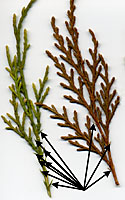Terry L. Ettinger Horticulture Consulting Services
Meeting The Needs Of Today With A Vision For The Future
Special Topics
Evergreen Identification
Siberian Cypress (Microbiota)
Siberian cypress (Microbiota decussata) looks a lot like groundcover-type junipers such as the very common `Andorra’ juniper (Juniperus horizontalis `Plumosa’). Its foliage even turns a bronzish-purple during the winter months, as does that of many junipers.
 Microbiota can be a little tricky to distinguish from low-growing
junipers as their leaves look quite similar. In fact, the main
differences are that they have fewer pointy, awl-shaped
leaves/needles as illustrated in the photo at left (a juniper
branchlet is at left, microbiota is at right). In addition, the branchlets
of microbiota tend to be more flattened than
those of juniper. Also, grabbing a handful of microbiota foliage
won't hurt as their needles
are soft and flexible.
Microbiota can be a little tricky to distinguish from low-growing
junipers as their leaves look quite similar. In fact, the main
differences are that they have fewer pointy, awl-shaped
leaves/needles as illustrated in the photo at left (a juniper
branchlet is at left, microbiota is at right). In addition, the branchlets
of microbiota tend to be more flattened than
those of juniper. Also, grabbing a handful of microbiota foliage
won't hurt as their needles
are soft and flexible.
Like junipers, microbiota is tolerant of very dry sandy/gravelly soils in full sun once established. I also can attest to this plant’s extreme cold hardiness as a number of plants I used to observe on an almost daily basis during my time as a student at the University of Minnesota thrived even though they were completely exposed to sweeping winter winds and -30ºF temperatures almost every winter!
However, despite its adaptability to harsh conditions in full sun, I often use microbiota in designs where I need a low-growing evergreen that will do well in spots receiving only dappled sunlight throughout the day. Unlike all other low-growing evergreens, microbiota actually do very well in light to moderate shade. Plus, their soft, “spray”-like texture works well with other plants that prefer dappled shade.
Unfortunately, while microbiota grows only two feet tall, it can easily spread ten to fifteen feet over the course of twenty years.